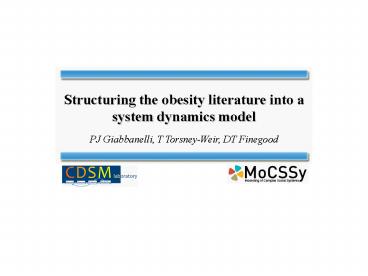Structuring the obesity literature into a system dynamics model - PowerPoint PPT Presentation
Title:
Structuring the obesity literature into a system dynamics model
Description:
Structuring the obesity literature into a system dynamics model PJ Giabbanelli, T Torsney-Weir, DT Finegood Outline Background Objective Model Conclusion Background ... – PowerPoint PPT presentation
Number of Views:124
Avg rating:3.0/5.0
Title: Structuring the obesity literature into a system dynamics model
1
Structuring the obesity literature into a system
dynamics model
PJ Giabbanelli, T Torsney-Weir, DT Finegood
2
Outline
Background
Objective
Model
Conclusion
3
Background
Recent mathematical models of obesity focus on
influences by peers.
Weight was directly spreading
? Bahr et al., Obesity 2009
? Hill, Rand, Nowak, Christakis 2010
4
Background
However weight is the result of the energy
balance.
We suggested a model in which behavioural norms
spread.
Giabbanelli, Alimadad, Dabbaghian, Finegood ICO
2010
Eating
Exercising
5
Background
We have models to understand influences between
individuals.
But we do not have models to understand the logic
of one individual.
6
Objective
We want to establish a new mathematical model of
obesity
that explicitly models determinants of weight at
the individual level.
The model must rely on findings from the
literature
structured using system dynamics.
7
Model
At the center of the model is energy balance.
One thing an individual may do with respect to
weight is weighing.
Weight monitoring is indeed efficient for weight
control (ONeil et al).
8
Model
You wont do anything particular for small
fluctuations (Resnicow et al).
You consider acting when you think there may be a
weight issue.
Your intention to change is a stock it builds up
over time.
9
Model
Gaining five pounds may not sound as strong as
reaching 200 pounds.
Particular values correspond to life events, with
a strong impact (Gorin).
You can think of similar pathways for estimations
of body size (Gardner et al.).
10
Model
Several psychological models explain how the
intention to change is translated into the actual
action (Schwarzer et al.)
The change feeds back into the system.
11
Model
Perceived self-efficacy may be hampered by
depression.
There are social and physiological mechanisms.
12
Model
13
Model
14
Model
We have 38 variables, and 52 interdependencies.
Depression
Stress
Energy balance
Intake monitoring
Exercise
Weight monitoring
Medical trigger
Change
Body size estimate
15
Model
Obesity is a complex phenomenon a more realistic
model is also complex.
If we stopped there, we would have only a
conceptual model.
But we want a mathematical model..
So we need numbers, and a good calibration of
that beast!
16
Model
We actually have pretty good numbers for several
of the relationships.
Healthiness issue youve developed diabetes.
56 of people seek counseling (Briscoe et al)
? poor reimbursement ? vague guidelines
? lack of time ? lack of training
Broad medical triggers are reported by 22.9 of
people in weight loss programs.
17
Model
We actually have pretty good numbers for several
of the relationships.
How much weight gain do antidepressants produce?
? Tricyclics 3.5 kg / 6 weeks old
? SSRIs 1 kg / 6 weeks gt50 market share
? Olanzapine 8.5 kg / 11 weeks (severe case)
? Aripiprazole 4.4 kg / 11 weeks
(Correll 2009 Ruetsch 2005 Olfson 2006)
18
Model
We actually have pretty good numbers for several
of the relationships.
How much more do individuals eat when with
friends? (social facilitation)
From 11 to 96, and most studies suggest between
40-50 (Herman)
19
Model
We actually have pretty good numbers for several
of the relationships.
How does it all turn into a change in weight?
Energy expenditure (MJ/d) Physical activity
(0.083Weight 0.85) 0.1 Energy intake
20
Conclusion
Mathematical models in obesity focus on the
spread of weight or behavioural norms between
individuals.
Using system dynamics, we propose the first model
of obesity that is individual-centered and based
on the literature.
21
Conclusion
There are limitations to this study.
? In order to be broad, we performed a
non-systematic review.
? some relationships may have been missed.
? Numbers are available for some relationships
but not for all.
? the mathematical model may have several
variables
? meaningful values may have to be estimated
through simulation
22
Conclusion
The next stage is to go from the conceptual model
onto the mathematical.
23
Acknowledgement
This works was supported by the Canadian
Institutes of Health Research (MT-10574) and the
Modeling of Complex Social Systems Program
(MoCSSy) at Simon Fraser University.
24
Conclusion































